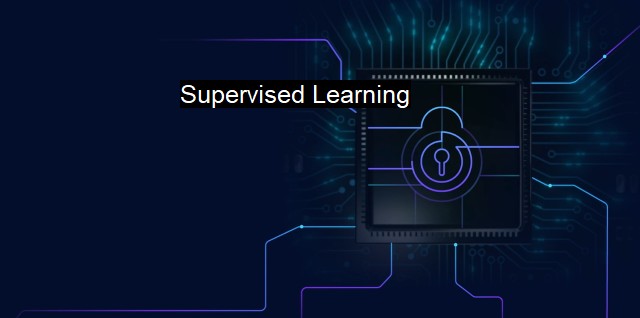What is Supervised Learning?
Supervised Learning in Cybersecurity: Protecting Against Increasing Threats in the Digital Landscape with Artificial Intelligence Technology
Supervised learning is a subfield of Machine Learning (ML) and Artificial Intelligence (AI) that refers to a predictive modeling method where an algorithm learns from data that is already labeled. The fundamental philosophy is to allow machines to learn by example. A dataset teaches the model to decipher certain information, in a manner where humans make decisions. It's often named "supervised" learning due to the process of training the model resembles how a person might train a pet by providing constant feedback.In cybersecurity and antivirus software development, supervised learning algorithms play a pivotal role in combatting the ever- evolving landscape of security threats. The growing sophistication and metamorphic nature of malware attacks necessitate the inclusion of advanced detection mechanisms.
The use of supervised learning brings tangible benefits to cybersecurity, notably by enhancing threat detection accuracy and efficiency.
Supervised learning models can identify patterns and behaviors associated with malware due to the ability of these learning models to observe previous examples, and accurately distinguish malicious activity from benign activity. Subsequently, these learning algorithms can predict the class or category of new or previously unseen data. They can deduce whether incoming network traffic consists of malware or not based on the data that has been input into their learning patterns.
More sophisticated cybersecurity solutions use dynamic analysis for prevention and detection, extracting features while the code is executed. This method requires even more complex supervised learning algorithms that observe network flows, system calls or the sequence of instructions inside a binary file for a more comprehensive malware analysis.
Data labeling penetrates to the heart of supervised learning. In the cybersecurity context, this means classifying the datasets into malicious and benign. The learning algorithm is 'trained' on this labeled dataset, where it learns associated behaviors with each category, whereas on moving to the 'unseen' or real-time environment, it starts making decisions – to label whether real-time network traffic is malicious or not.
Despite the promising prospects of supervised learning some challenges remain. Algorithms need accurate and large-scale data for the training phase, which may not always be readily available in real and unique situations. Following that, developing the appropriate model can be immensely challenging due, considering a multitude of factors and variables associated with network traffic or user behavior. The presence of false positives and negatives persistently stimulate the requirement for new path-breaking approaches to complement supervised learning.
Supervised learning is prone to overfit trying to fit the dataset provided during training too closely, and may not be able to generalize usage on datasets that it has not previously encountered. Lastly, but significantly, the model's efficiency is as elevated or reduced as the quality of data that it has to learn.
Something worthy of mentioning is that cyber threats are ever-evolving. As methods to detect malware effectively increase, so does sophistication's degree, which malware adopts while being built. As a result, continuous re-training of the algorithm to accommodate newer types of malware is essential, and cybersecurity professionals must take the lead here.
Supervised learning is an extremely promising method with the potential to improve cyber attacks detection and prevention significantly. By integrating it into antivirus programs and security processes, organizations can heighten resilience against severe cyber threats. Future advances may tackle currently faced challenges, and in the merger with other AI approaches, like reinforcement learning and deep learning, may present even more potent cybersecurity solutions. But remember, technology is a double-edged sword as cyber attackers, increasingly utilize AI sophistications to launch attacks making cybersecurity a consistent battle of escalation.

Supervised Learning FAQs
What is supervised learning in the context of cybersecurity and antivirus?
Supervised learning is a type of machine learning where an algorithm learns from labeled data, using it to make predictions on new, unseen data. In the context of cybersecurity and antivirus, supervised learning can be used to train models that can classify malware and detect threats in real-time.How does supervised learning help in antivirus software?
Supervised learning helps antivirus software by allowing it to learn from labeled data, such as known viruses and malware, to accurately identify and classify new threats. This enables the software to detect and remove potential threats before they can cause harm.What are some examples of supervised learning algorithms used in cybersecurity and antivirus?
Some examples of supervised learning algorithms used in cybersecurity and antivirus include decision trees, logistic regression, support vector machines (SVMs), and neural networks. These algorithms can be trained on labeled data to identify patterns and make accurate predictions.What are the benefits of using supervised learning in cybersecurity and antivirus?
The benefits of using supervised learning in cybersecurity and antivirus include improved accuracy in threat detection, faster response times to new threats, and the ability to adapt to changing threat landscapes. This helps organizations stay ahead of potential cyber attacks and protect their data and systems.| | A | | | B | | | C | | | D | | | E | | | F | | | G | | | H | | | I | | | J | | | K | | | L | | | M | |
| | N | | | O | | | P | | | Q | | | R | | | S | | | T | | | U | | | V | | | W | | | X | | | Y | | | Z | |
| | 1 | | | 2 | | | 3 | | | 4 | | | 7 | | | 8 | | |||||||